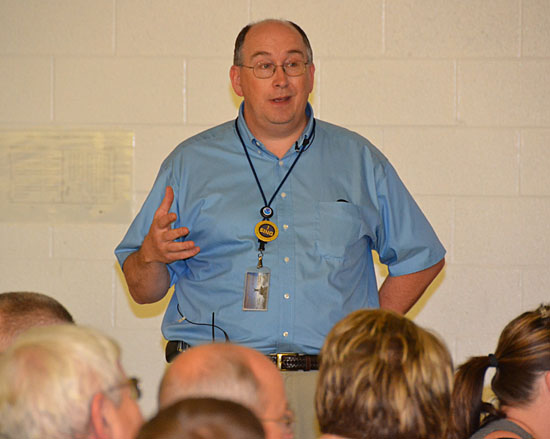Weather spotter training draws big crowd
DAVE MOSIER/independent editor

With spring now officially sprung, Van Wert County can now look forward to the possibility of severe weather occurring at just about any time for the next several months.
Moreover, as shown by the turnout at Thursday evening’s weather spotting training, interest in severe weather has never been greater. Approximately 120 people — the highest number ever — showed up at the Lincolnview Elementary School cafeteria to participate in training that would allow them to be weather spotters.
“This is the largest crowd we’ve ever had,” Van Wert County Emergency Management Director Rick McCoy said, adding that more than 90 people signed up on his Facebook page alone for the seminar.
Those taking the training included first responders, as well as county residents from all walks of life.
As McCoy was quick to point out, though, weather spotting is not the same thing as storm chasing.
“This class is not for you to be a storm chaser,” McCoy told those attending. “We don’t want to see you on National Geographic getting killed.”
He also noted that weather spotters are most valuable when they factually report what they’re seeing outside their residence, business or just while they’re out driving in the county when a storm occurs.
Michael Lewis, NWS weather coordination meteorologist, conducted Thursday’s training session, which because of federal funding cuts, is now only held every other year in the county, instead of annually as in the past.
“Our goal is to get new eyes out there of what’s going on, not only what they’re seeing during the storm but afterwards,” the local EMA director said of the weather spotter training. McCoy noted that damage reports are particularly important after a storm passes. “Sometimes we don’t receive damage reports until days after a storm.”
Lewis showed people what to look for, as far as severe weather events go, and how to get pertinent information ahead of time through the National Weather Service website and its Storm Prediction Center, as well as other resources.
Lewis also provided procedures on how to get that information to McCoy and the National Weather Service.
According to McCoy, it’s vitally important to have a large number of weather spotters in all portions of the county to provide information on what’s happening during, and after, a storm.
“We’re looking for a number of things, including the presence of hail and hail size, wind damage, flooding issues, and the presence of wall clouds, funnel clouds or tornadoes – the severe aspects of a storm,” he said.
McCoy said storm spotters should also report any crashes, power outages or fires caused by the storm, as well as storm-related property damage.
POSTED: 03/23/12 at 5:32 am. FILED UNDER: News







